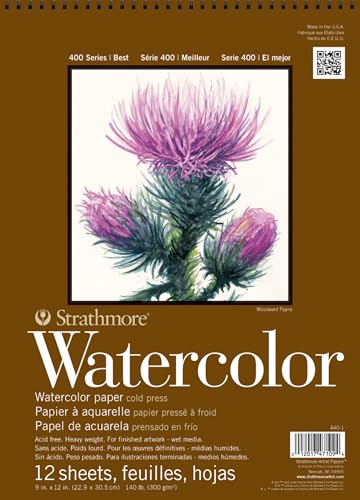
How to Paint a White Rose in Watercolor Painting, watercolor is a unique medium, moreover, it is a versatile medium that offers many possibilities for artistic expression. Furthermore, its loose character and unpredictable results are among the most attractive things about watercolor.
By using watercolor to paint the white rose, we can capture the lightness and delicacy of the petals, which artist Huang Youwei will guide us through detailed step-by-step instructions below.
You can also discover another flower tutorial: how to paint a yellow rose with watercolor.
Paper: Saunders Waterford watercolor paper, Cold press, 300gsm, 31cmx41cm
Pigments: Bright Violet, Lemon Yellow, Permanent Yellow, Yellow Ocher, Ultramarine Blue, Cobalt Blue, Payne’s Grey, Phthalo Green Dark, Pernament Green, Red Ocher.
Brushes: Calligraphy brush, Rigger Brush, Rough brush
Other: 6B pencil, Pallette, Water bucket, Drawing boat, Masking tape.
Best deals on the materials you need
| Preview | Product | Rating | Price | |
|---|---|---|---|---|

|
Strathmore 440-1 400 Series Watercolor Pad, 9"x12" Wire Bound, 12 Sheets | No ratings yet |
$9.74 |
Buy on Amazon |

|
Winsor & Newton Cotman Watercolor Paint Set, Sketchers' Pocket Set, 12 Half Pan w/ Brush | No ratings yet |
$22.23 |
Buy on Amazon |

|
U.S. Art Supply 5.5" x 8.5" Watercolor Book (2 Pack, 76 Sheets Each) - 110lb (230 GSM) Linen-Bound... | No ratings yet |
$18.99 |
Buy on Amazon |

|
ARTEZA Watercolor Paint Brushes, Set of 5, Assorted Shapes, Synthetic Soft-Bristle Brushes | No ratings yet |
$17.78 |
Buy on Amazon |
Getting Started
To begin, I recommend starting with a 6B pencil to ensure the gray is dark enough to highlight the lines and lightly sketch out the basic lines to create the overall shape of the rose. Take your time with this step to ensure the proportions are correct and pay attention to the details of the rose petals.
By using the eraser gently, you can create a bit of fuzziness in the petal shape without completely erasing it. This can be a great way to refine the overall shape of the petal, while still maintaining its basic structure and form.
Start Painting The White Rose
Wet a petal with a small brush filled with water, make sure the entire surface of the petal is evenly moistened before you start painting.
To create a light gray color, use a mixture of various colors such as ultramarine blue, dark blue, permanent rose, permanent Violet, Payne’s Grey, and a touch of yellow ocher. By mixing these colors in the right proportions, you will be able to create a beautiful light gray color.
Besides, note that when creating the warm tones seen in the middle of the petals, Lemon Yellow and Permanent Yellow are the recommended colors to use. These two colors can help to add brightness and depth to the painting.
Even though they are just small petals, they have many hues, reflections, and borderlines between light and dark. Please observe carefully so as not to miss this subtlety.
We tend to only see the overall shape and color of flowers, but if we look closer, we’ll notice that each petal has its own unique shade and texture. Such as values, hue, reflections, and lines between light and dark.
The flower is finished and now we see it’s a bit empty because the white background looks quite monotonous.
Start painting the branches and leaves
The characteristic of rose branches is that they are relatively thin; However, you can draw the branches a little thicker but pay attention to the proportions of the flowers.
Paint the first layer using colors such as ultramarine blue, Pernament Green, Phthalo Green Dark, and Cobalt Blue.
Wait for it to dry completely and continue to make it darker by painting another layer, paying attention to the details of the veins on the underside of the leaf.
Paint the background
Before you’re ready to paint the background, redraw the outline of the rose with a pencil. Because I’m afraid the water will go over the edge when painting and lose the shape of the flower.
I often use the wet-on-wet painting method, by wetting the paper with water before painting the background. Backgrounds painted with this technique are relatively smooth, loose, and delicate, which can effectively highlight the subject.
Furthermore, this method can be divided into zones to paint extremely complex changes in light.
First, wet the entire top right side of the paper, the wet area should be as large as possible. In terms of color, I like the background to have gray tones, so here I used a mixture of dark green, dark purple, dark blue, Payne’s Grey and added a touch of Red Ocher
Use the same way to paint the remaining parts of the painting. Add a few small flecks of light, using a hard brush and gently wash off the paint. The painting instantly looks better.
The lower part of the picture is painted and some green is added, giving the impression that there are other flowers and leaves in the distance.
Final of How to Paint a White Rose in Watercolor Painting
And that’s it, if you want to try painting this painting yourself, don’t wait any longer, let’s do it.
Suggested content
How To Paint Seascape in Watercolor
In this tutorial, we’ll be learning how to paint a simple seascape with watercolors.

